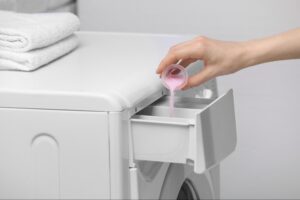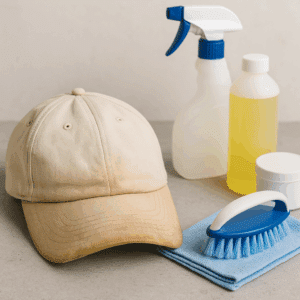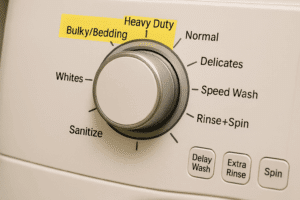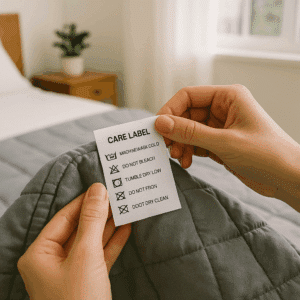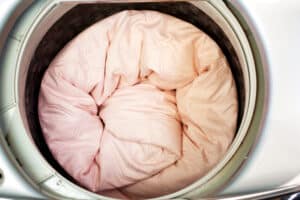How To Remove Armpit Stains
We’ve all pulled out a favorite shirt only to find those dreaded armpit stains – yellow underarm marks on white shirts or stiff, discolored patches on colored fabrics. Don’t toss that shirt just yet! Learning how to remove armpit stains is easier than you think, and you can do it with simple household items. In this guide, we’ll show you how to get rid of armpit stains from both white and colored clothing, share time-saving home remedies (like baking soda for armpit stains and vinegar), and offer tips to prevent pit stains in the first place. We’ll also let you know when it’s best to call in professional help for those really stubborn spots. Let’s dive in, neighbor – your fresh, clean shirts await!
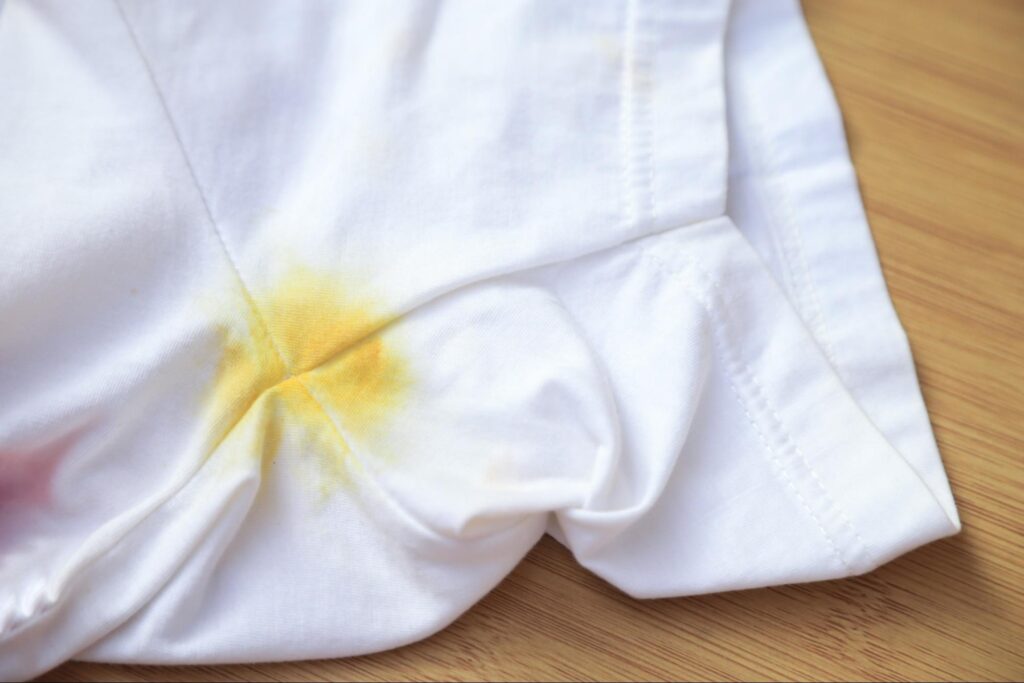

Why Do Armpit Stains Happen?
First, a quick insight into why these stains show up. Sweat itself is mostly water, but when it mixes with the ingredients in your deodorant (especially aluminum in antiperspirants) and the natural oils and proteins in your sweat, it triggers a reaction that causes those yellowish stains. In fact, aluminum salts from deodorant are a main culprit – they combine with sweat and fabric, leaving white streaks or yellow patches over time. The result? Unsightly marks that can stiffen fabric and trap odors. The good news is that these stains are protein-based, which means they can be tackled with the right approach. Just remember: the sooner you treat them, the better. Letting sweat and deodorant build up or – worst of all – throwing a sweaty shirt in the dryer can set the stain and odor, making it much harder to remove.
How to Get Armpit Stains Out of White Shirts
Yellow armpit stains on white shirts are a common laundry woe. Luckily, there’s a tried-and-true armpit stain remover routine that works wonders on white cotton shirts. Here’s how to remove those yellow underarm stains from white clothing:
- Pre-treat with a baking soda & peroxide paste: The combination of baking soda and hydrogen peroxide is a powerful one-two punch for whitening stains. Mix equal parts baking soda, hydrogen peroxide, and water to form a paste (for example, 1/4 cup of each). Apply this paste to the yellowed underarm areas, gently scrubbing it in with an old toothbrush or soft brush to help it penetrate the fabric.
- Let it sit: After applying the paste, let the garment sit for about 20 to 30 minutes. This gives the baking soda and peroxide time to break down the sweat residue and deodorant buildup that cause discoloration. (For very stubborn, set-in stains, you can even leave the paste on for up to an hour before washing.)
- Wash in warm water: Launder the shirt as usual, using the warmest water temperature safe for the fabric (check the care label). Warm water helps activate the cleaning power on protein-based stains like sweat. Use a quality detergent and run a normal cycle.
- Air dry and check: Avoid the dryer for now – heat can “bake in” any lingering stain. Instead, air dry the shirt and then inspect the underarms in good light. If any yellow traces remain, repeat the treatment before machine-drying. (Never use chlorine bleach on sweat stains; it can actually react with the proteins and make the yellowing worse!)
This method works especially well for white cotton shirts – cotton stands up to the paste and tends to respond best, often restoring that crisp white look. Hydrogen peroxide for armpit stains acts as a mild bleach to whiten the area, while baking soda lifts stains and neutralizes odors. Just remember to handle delicate fabrics more gently: if the shirt is made of silk or wool, skip the peroxide and consider a different approach (or professional cleaning), since peroxide could damage those materials.
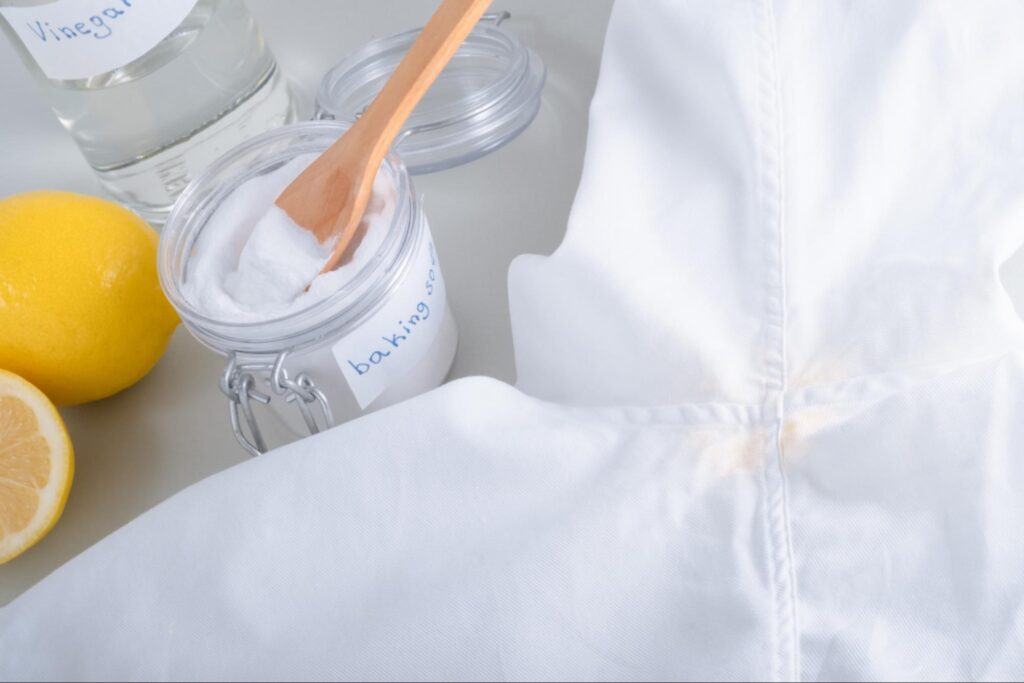
How to Get Armpit Stains Out of Colored Shirts
Removing armpit stains from colored shirts can be a bit trickier – you want to get the stain out without fading the fabric. The yellowing might be less obvious on dark or bright colors, but you might notice darkened patches, stiffness, or even a whitish deodorant buildup. Here’s how to get armpit stains out of colored shirts safely:
- White vinegar soak: Plain white vinegar is a hero for colored clothes. Mix equal parts distilled white vinegar and water in a bowl or sink (for example, 1 cup vinegar + 1 cup water). Dip a soft brush or cloth in this solution and gently scrub the underarm areas of your shirt. After scrubbing, let the shirt soak in the vinegar-water solution for about 30 minutes. The vinegar helps loosen deodorant residue and sweat salts that cause discoloration, all while being gentle on colors.
- Baking soda paste (color-safe): If you prefer, you can also use a baking soda and water paste on colored fabrics. Baking soda is mild enough for most colors and fabrics. Apply the paste and let it sit for 15-20 minutes before washing. (It’s always wise to do a spot-test on an inconspicuous area of a bright or delicate colored shirt, just to be sure the color doesn’t change.)
- Wash in cool water: After vinegar soaking or baking soda treatment, wash the shirt in cool or lukewarm water with your regular detergent. Avoid hot water for bright or dark colors, as it can cause fading. Again, skip the dryer until you’re sure the stain is gone – air dry the garment and check the underarm area. If discoloration remains, you may repeat the vinegar soak or try an alternative remedy before drying.
Avoid using hydrogen peroxide or bleach on colored shirts, unless you’ve tested it on a hidden spot. Peroxide can act like bleach and may lighten the fabric dye. The vinegar method is usually effective for removing the sweat smell and stiffness from colored clothing without bleaching the fabric. As a bonus, vinegar also neutralizes odors and can soften the fibers. And if you ever get those chalky white deodorant streaks on a dark shirt, here’s a quick neighborly tip: gently rub the area with a pair of nylon stockings or a clean dry cloth – the friction will lift the deodorant marks right off!
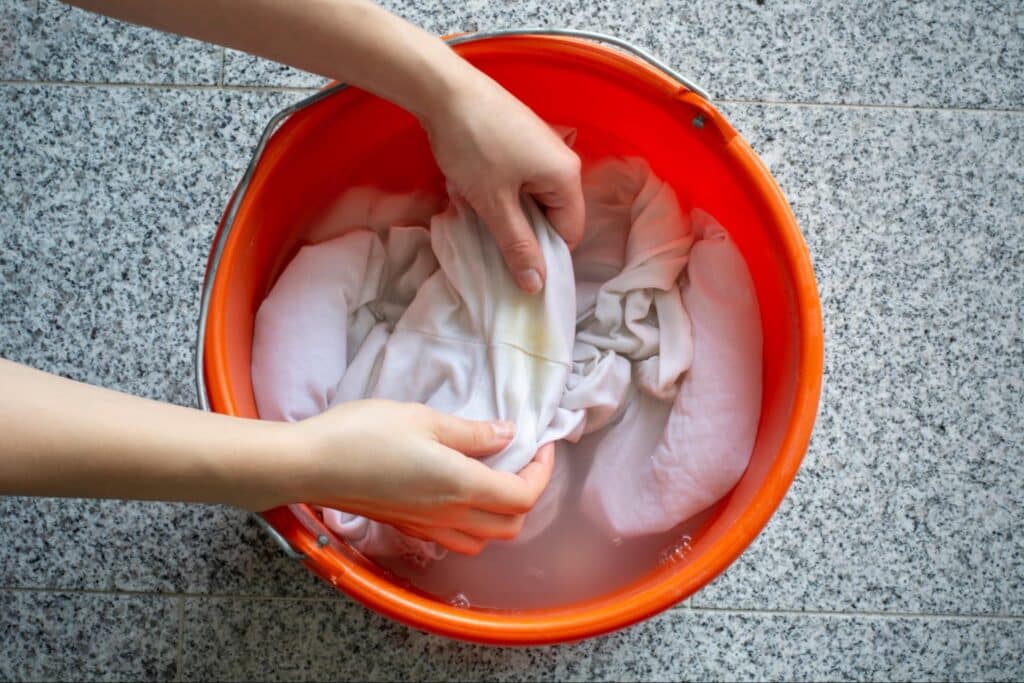
More DIY Remedies for Stubborn Armpit Stains
If the basic methods above aren’t completely doing the trick, don’t worry. There are a few more home remedies and tricks that can help remove armpit stains and their residue. These are especially handy for set-in stains or for those who love a good DIY hack:
- Aspirin Solution: Got a couple of uncoated aspirin tablets? Crush two aspirin and mix the powder in 1/2 cup of warm water. Soak the stained area of the shirt in this solution for 2-3 hours, then wash as normal. Aspirin contains a form of salicylic acid that can help break down sweat stains (who knew!).
- Salt Water Rub: Dissolve about four tablespoons of table salt into a litre (about a quart) of hot water. Let it cool slightly, then sponge the salty solution onto the armpit stains. Gently rub or scrub the area as you apply. Salt can help scrub out the stain and absorb perspiration oils. Rinse and wash the garment after treatment.
- Lemon Juice: Lemons aren’t just for lemonade – their citric acid can help lift stains. Squeeze equal parts lemon juice and water onto the stain (about two tablespoons each). For white shirts, you can even lay the garment in the sun for an hour after applying lemon juice – the sunlight works with the lemon’s natural bleaching effect to help fade the stain. (Just be cautious using lemon on colored shirts or delicate fabrics, as it might have a lightening effect.) After treating, rinse out the lemon to avoid any sugar residue and wash the shirt.
- Oxygen Bleach Soak: For really tough yellowing (and only on color-safe or white fabrics), an oxygen-based bleach can be a lifesaver. Products like OxiClean (oxygen bleach) can be mixed with water per the package instructions and used to soak the garment for several hours (or overnight). Oxygen bleach is gentler than chlorine bleach and safe for many colored fabrics, but it still brightens and breaks down stains. Always check that your item is labeled color-safe for bleach before using this method.
- Store-Bought Stain Remover: When in doubt, you can try a commercial stain remover spray or stick designed for laundry. There are even specialty “armpit stain remover” products out there. Follow the instructions on the product – typically you’ll apply, let it sit, then wash. This can be just as effective as DIY methods, especially if you’re dealing with very old stains. Just remember to still avoid the dryer until you know the stain is gone.
With any of these methods, be sure to rinse thoroughly and wash the clothing after treatment. And as always, check the garment’s care label before applying any solution that might be harsh on the fabric. When working on an unfamiliar fabric or color, test your solution on a hidden spot to make sure it doesn’t affect the dye. Patience is key with set-in stains – you might need to repeat a treatment a couple of times, but it will save your shirt in the long run.


How to Prevent Pit Stains
Now that you’ve learned how to get armpit stains out of white shirts and colored shirts, let’s talk prevention. After all, the easiest stain to remove is the one that never happens! Here are some smart, neighbor-approved tips on how to prevent pit stains from forming in the first place:
- Switch your deodorant: Consider using an aluminum-free deodorant or an “anti-stain” antiperspirant formula. These are designed to minimize the chemical reaction that causes yellow stains, so you get sweat protection without the laundry drama.
- Let deodorant dry before dressing: If you apply deodorant or antiperspirant and then jump straight into your shirt, you’re more likely to get residue on the fabric. Instead, give it a minute or two to dry. If you’re in a rush, you can even use a hairdryer on a cool setting for a few seconds to speed it up. Dry deodorant means less transfer onto your clothes (and no more white streaks on that black top!).
- Wash sweaty clothes promptly: Don’t let sweaty gym tees or work shirts ferment in the laundry basket all week. The longer sweat sits in fabric, the more time it has to discolor and set in. Try to wash items after each heavy wear, or at least rinse the underarm area with water if you must delay laundry. Never leave damp, sweaty clothes balled up in a gym bag – that’s just asking for stains (and odors) to latch on.
- Wear an undershirt or sweat guards: If you’re wearing nice dress shirts or silk blouses, consider an undershirt or disposable underarm sweat pads. A thin cotton undershirt (even a basic white tee or tank) can absorb sweat and oils before they reach your outer shirt, keeping it free of stains. This extra layer is especially handy on hot days or if you know you’ll be sweating more than usual.
- Apply antiperspirant at night: Here’s a pro tip: applying antiperspirant at bedtime can reduce sweat the next day. At night, your body is cooler and sweat glands are less active, so the product has time to sink in and plug those sweat ducts effectively. Come morning, you’ll still be protected, and you can do a light touch-up if needed. This reduces the chance of product overload rubbing off on your clothes come morning.
In short, a few routine changes can save you from scrubbing stains later. Use a bit less deodorant (over-applying can lead to excess residue), choose formulas that are easier on fabrics, and keep your clothes clean. By staying ahead of the stains, you’ll keep your shirts looking fresher for longer.


When to Consider Professional Laundry Help
Sometimes, despite our best efforts, a pit stain just won’t quit. Perhaps it’s an old, set-in stain that has been through the dryer one too many times, or a delicate fabric you’re nervous about treating at home. This is when knowing your local laundry professionals comes in handy. Here are a few scenarios where you might want to seek expert help:
- Stains that won’t come out: If you’ve tried the above remedies and that yellow patch is still smiling back at you, it might be time to let a pro take a crack at it. Professional cleaners have commercial-grade stain fighters and techniques (like specialized soaks or spot treatments) that can sometimes rescue garments when home methods fail.
- Delicate or dry-clean-only items: For fabrics like silk, satin, wool, or any garment labeled “dry clean only,” home stain removal is risky. It’s better to take those to a professional dry cleaner to avoid damaging the material. They’ll know how to treat the stain safely.
- No time or energy: Life gets busy, and not everyone wants to play stain scientist after a long day. There’s no shame in handing off a challenging laundry problem to save your time. Consider using a convenient service like Wash & Fold or scheduling a pickup & delivery laundry service. At SpinCycle Laundry, for example, our team pre-treats stains and washes your clothes with care – a great option if you have multiple stained items or just want an expert to handle it.
The bottom line: if a stain is really set in or you’re dealing with a pricey garment, a professional cleaning can be a worthwhile investment to save your clothes. We’re your neighbors in the fight against stains, and we’re happy to help when you need it!
Armpit stains might be stubborn, but they’re not invincible. With a little elbow grease (and perhaps some baking soda and vinegar), you can vanquish those yellow underarm stains and extend the life of your favorite shirts. Remember to act quickly, be gentle on your fabrics, and don’t hesitate to call in help for the tough jobs. Here’s to looking sharp, staying fresh, and never letting a pit stain ruin your day or your outfit. Happy laundering!










